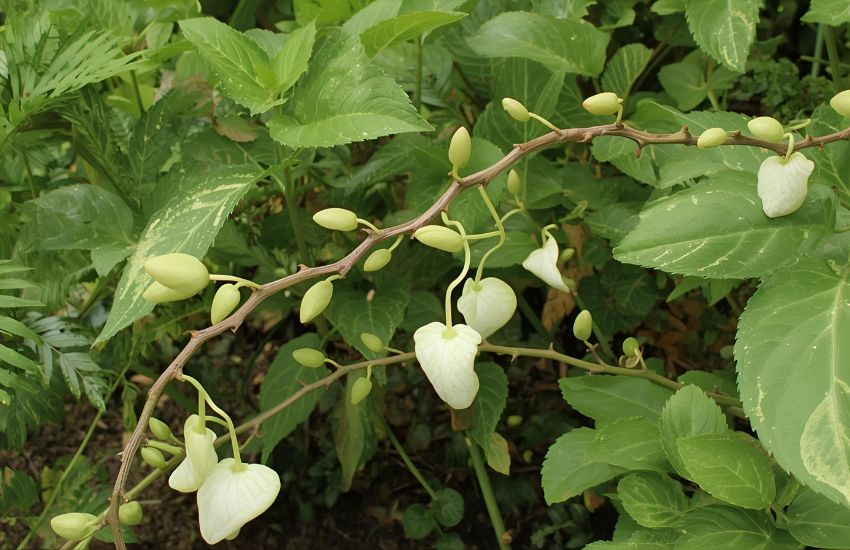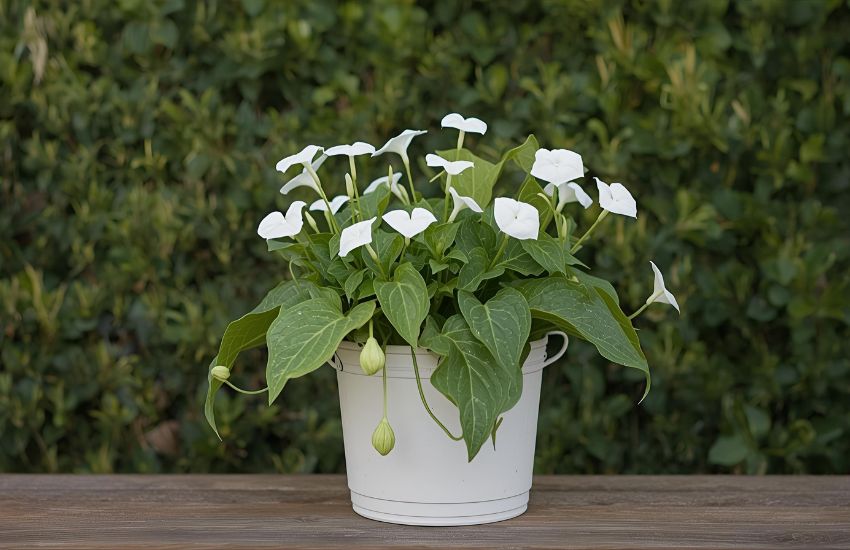Delicate in appearance but resilient at heart, the butterfly plant—more formally known as the Syngonium White Butterfly—offers you a graceful, low-maintenance way to bring natural beauty into your indoor space. With its pale green arrow-shaped leaves edged in creamy white, this fast-growing vine adds charm and a sense of calm to any room. If you’re seeking an easy to care plant that thrives in indirect light and responds well to basic care, the arrowhead vine may be your perfect companion.
The Syngonium White Butterfly thrives in bright, indirect light, well-draining soil, and higher humidity. Water when the top inch feels dry, and fertilize monthly during the growing season. Prune to maintain shape and encourage bushier growth. Use neem oil for pests. This low-maintenance vine adds beauty and calm to indoor spaces with its elegant arrow-shaped leaves.
In this care guide, you’ll learn how to select the right potting mix, manage light and waterings, avoid stress from direct sunlight, and properly repot when needed. You’ll also discover seasonal tips and expert advice for growing a thriving white butterfly arrowhead plant.
How to Grow and Care for the Syngonium White Butterfly Plant

The Syngonium White Butterfly—also known as arrowhead—is a graceful tropical plant admired for its elegant arrow-shaped leaves that often resemble butterfly wings. With proper attention, this variety of syngonium podophyllum can become a stunning addition to your indoor collection. Below are essential plant care guidelines to help you nurture a thriving and healthy plant.
Light and Temperature Requirements
To ensure your plant thrives, place it in bright indirect light. Avoid exposure to direct sunlight, which can scorch the leaves. The syngonium white butterfly’s foliage performs best under consistent light conditions between 60–85°F. To maintain the right environment, monitor your temperature and humidity, especially in dry climates. If needed, use a humidifier to replicate the plant’s native tropical habitat.
Watering and Soil Conditions
Keep the evenly moist soils without overwatering. Poor drainage can lead to root rot, a common issue in syngonium plants. Use a well-draining mix rich in organic matter, and make sure your pot has sufficient drainage holes to protect the roots.
Potting and Repotting
As the plant grows, you’ll eventually need to transfer it to a larger pot. Select a container with ample drainage and fill it with soil that supports both moisture retention and airflow. A mature plant may need to be repotted every 1–2 years to support root development and sustained health.
Pruning and Growth Management
To control size and encourage fuller growth, prune older vines regularly. Trimming is not only a great aesthetic strategy, but it also promotes a bushier, more compact structure. Pruning can help your syngonium white butterfly care routine by managing legginess and keeping the shape uniform.
Pests and Safety
Keep an eye out for common pest issues such as spider mites, aphids, and mealybugs. Wipe the leaves with a damp cloth or treat infestations with insecticidal soap. Note that this plant is mildly toxic when ingested, so it’s best kept away from pets and small children. It’s advised to wear gloves or wear gloves when handling the plant, especially during pruning, as the sap may irritate sensitive skin.
Propagation, Repotting, and Fertilizer Tips for a Flourishing White Butterfly Vine

- The white butterfly vine is easily propagated using stem cuttings, ideally taken during the spring and summer months when the plant is actively growing.
- To propagate successfully, identify a new growth shoot with a visible node, then place the cutting in water or moist soil until roots form.
- Make sure temperatures remain above 60 degrees to support healthy propagation and root development.
- Repotting is necessary when the plant becomes root-bound or the soil starts compacting.
- Always use a container with drainage holes and a well-draining potting mix to avoid excess moisture and root rot.
- Water only when the top inch of soil is dry to the touch and ensure proper drainage to protect the roots.
- During the growing season, you need to fertilize monthly with a balanced houseplant fertilizer or liquid fertilizer to encourage vibrant foliage and steady growth.
- Be careful not to over-fertilize, as this can lead to leaf burn.
- While the plant tolerates average humidity, it prefers higher humidity for optimal health. Boost humidity levels with a humidifier or occasional misting.
- Keep an eye out for pests such as spider mites and aphid. Treat infestations promptly using neem oil or insecticidal soap to avoid long-term damage.
- As the plant contains calcium oxalate, which may cause skin irritation or difficulty swallowing if ingested, keep it out of reach of pets and children.
- Always wear gloves when handling the plant, especially when pruning or repotting.
Conclusion
Caring for the Syngonium White Butterfly is both rewarding and simple when you understand its needs. With its graceful colors and patterns and adaptable nature, this easy houseplant fits beautifully into a variety of indoor settings. Whether placed near a bright window or trailing from a trellis, its lush foliage brings a calming, decorative touch to your home.
To keep it thriving, remember the essentials: maintain higher humidity, avoid issues caused by overwatering, and monitor for any signs of leaf burn. You’ll also need to fertilize regularly during the growing season to support healthy development. If pests like spider mites or aphids appear, treat them promptly with gentle solutions like neem oil. Though not entirely resistant to pests, the plant bounces back well with consistent care.
If you love this plant and want to see it flourish, consider placing it in a kitchen or bathroom where natural high humidity helps it thrive. With the right environment and attention, your White Butterfly Syngonium will continue to grow with elegance and ease.
Frequently Asked Questions (Syngonium White Butterfly Plant Care Guide for a Thriving Arrowhead Vine)
How to care for a syngonium white butterfly plant?
To care for a Syngonium White Butterfly, place it in bright, indirect light and keep the soil consistently moist but not soggy. Water when the top inch feels dry. Maintain humidity and temperatures between 18–27°C. Fertilize monthly during growing season with balanced liquid fertilizer. Prune regularly to encourage bushy growth and prevent legginess.
How do you care for arrowhead Syngonium?
Care for an arrowhead Syngonium by placing it in bright, indirect light and keeping the soil evenly moist but not waterlogged. Water when the top inch feels dry. Maintain humidity with misting and keep it in temperatures between 18–27°C. Fertilize monthly during spring and summer. Prune regularly to control growth and encourage bushiness.
Does Syngonium need sunlight?
Syngonium plants need bright, indirect sunlight to thrive but should be protected from direct sun, which can scorch their leaves. They can also tolerate low-light conditions, making them suitable for indoor spaces. Place them near a window with filtered light for best growth. Too little light may slow growth and dull leaf color.
How to take care of a white butterfly?
To care for a White Butterfly (Syngonium), place it in bright, indirect light to maintain its variegation. Keep the soil consistently moist but not waterlogged, watering when the top inch feels dry. Maintain humidity and temperatures between 18–25°C. Fertilize monthly in the growing season and prune to encourage fuller growth.
